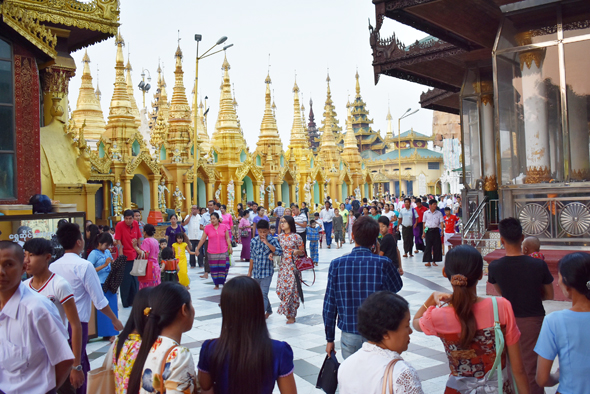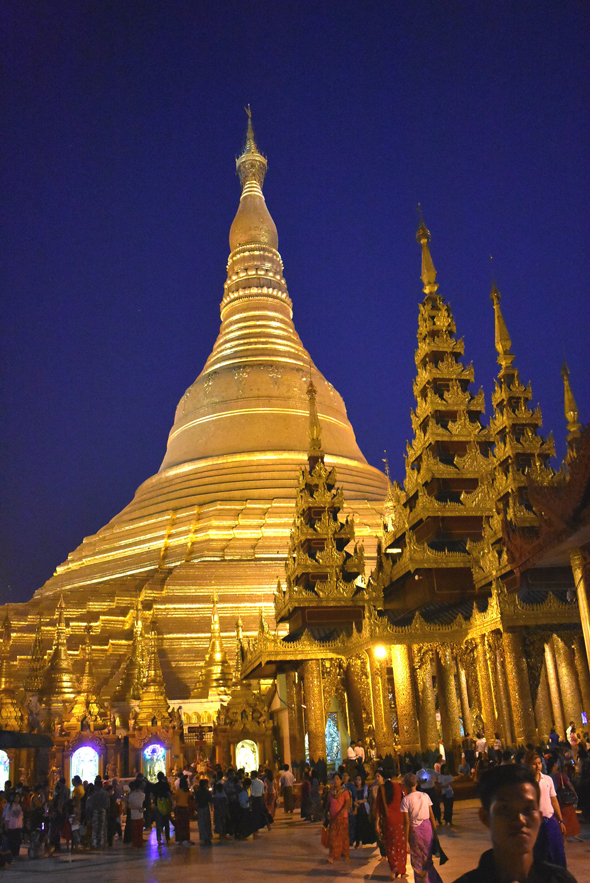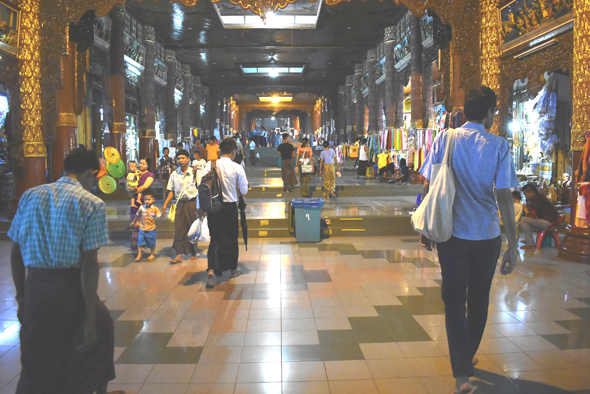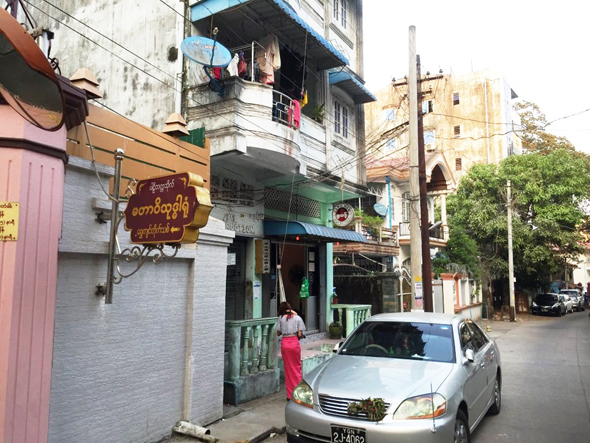A Drumbeat for Help Awakens the Spirituality of Yangon
Saved under Community, Current Stories, Travel
Tags: Baytown, Clear Lake, Cypress, Desi news, Greater Houston, Houston, Houston Desi news, India, Indian American community, Indian News, Indians in America, Indo-American News, Katy, NRI, pearland, Shwedagon Pagoda, south asia, South India, Sugar Land, Texas, USA, Yangon
By Jawahar Malhotra
YANGON, MYANMAR: We had just left the Jana Mon Ethnic Cuisine restaurant on Nandawon Street, a short taxi ride away north of the towering Shwedagon Pagoda site and were walking back past the residential area, a little past 9:30 at night. The restaurant, which serves ethnic Mon food, is a favorite of the local expatriate community and has been written up in the local press. It is a tiny place with six tables, a modern, hip ambiance and a snappy menu of food from the Mon state, which lies just east of Yangon, bordering the Andaman Sea.
The restaurant is a walk up with a warm glow of light emanating from its perpetually open door, and is located down a small dimly lit lane that leads to six-story tall residential apartments and clusters of two-story homes surrounded by brick walls. As with most other parts of the city, the buildings have a tired, worn out look, with dark patches of weather-beaten stains on the dull whitewashed walls and drying laundry hung off balconies.
A small shop catering to basic items had a few customers, a few people sauntered by in rubber flip-flops and a group of little kids played near their parents in the light of an occasional streetlight. Some cars were parked on one side of the road, but traffic was sparse so we walked till the end of the lane to catch a cab. A woman in a long printed sarong, blouse with mid-arm sleeves, an angular headwrap and flip-flops approached on the far side, a bundle tied in a long cloth slung across one shoulder, a child on her hip.
She stopped in a small clear spot, let the child down to scamper, sat on her haunches, pulled out a small drum and started to play a low-tone, monotonous beat. After a punctuated silence, she beat the same notes again and repeated it as she waited. My son Jeremy, who had been living in Yangon for the past year (and had become equally comfortable in flip-flops), explained that this was the way people beckoned for alms when they were destitute. The low pounding beats traveled down the street and sure enough, a few people walked up to her and handed her some loose change or bowls of food.
All across the city, the same ritual is repeated daily, but not to the point of annoyance, as poor people sit on their haunches, and beat a drum like a sign of their last resort to get by or eat. It is a practice that is rooted in the Buddhist monks way of begging for alms, of throwing themselves at the mercy of the world when all else fails. And in a deeply spiritual society, the plea is quickly responded to.
On a Saturday night, remarkably cool for mid-March, the Shwedagon Pagoda complex is packed with people who throng to pay homage to their personal mini-shrine in a ritualistic slow walk around the main, central towering 99 meter (325 ft) tall gold-gilded stupa. They come by the family-loads, up the four entrances aligned to the directions of a compass, built on Singuttara Hill, 168 ft above the rest of the city. The complex is located to the west of Kandawgyi Lake, and dominates the Yangon skyline. Down the western entrance which has been outfitted with escalators for those who cannot climb the stairs, at the base, just outside the gates, on U Wisara Road, you can get a roaming taxi to whisk you off into the surrounding dimly lit city.
You enter through a long, wide covered hall, each with its own distinctive name and function , walking up flights of short stairs, past the stalls and stores selling religious artifacts and to a ticket booth where foreigners pay 10,000 kyat ($8) and are asked to dress modestly. Those with more exposed skin can buy cheap shawls for 3,000 kyat ($2.50) to drape across their arms and shorts, and there is a place to drop off your shoes, or you can carry them in a plastic bag. The marble slabs feel cool to your barefeet as you walk clockwise, starting from the eastmost shrine, around the 1,420 ft perimeter of the base of the pagoda. In one courtyard, there is a banyan tree grown from a sapling transplanted here from the original one Buddha taught under in Bodhigaya, India and people sit by its boughs to meditate.
As dusk descended and the floodlights came on, the gilded stupa lit up in the brilliance and a throng of foreign tourists stand armed with their cellphones and cameras to catch the spectacle of the soaring stupa with festive streams of triangular flags strung across its lower curve and a large flag-shaped vane at the very peak. In the Eastern Devotional Hall, a group of devotees pray in lilting harmony at the shrine to the Buddha, oblivious of the people and commotion behind them. This is the echo of the spirituality that holds them to give to those who beat a drum across a city that is seeing such massive changes as it transforms.




